transmission fluid FORD GT 2018 Owners Manual
[x] Cancel search | Manufacturer: FORD, Model Year: 2018, Model line: GT, Model: FORD GT 2018Pages: 325, PDF Size: 6.61 MB
Page 6 of 325
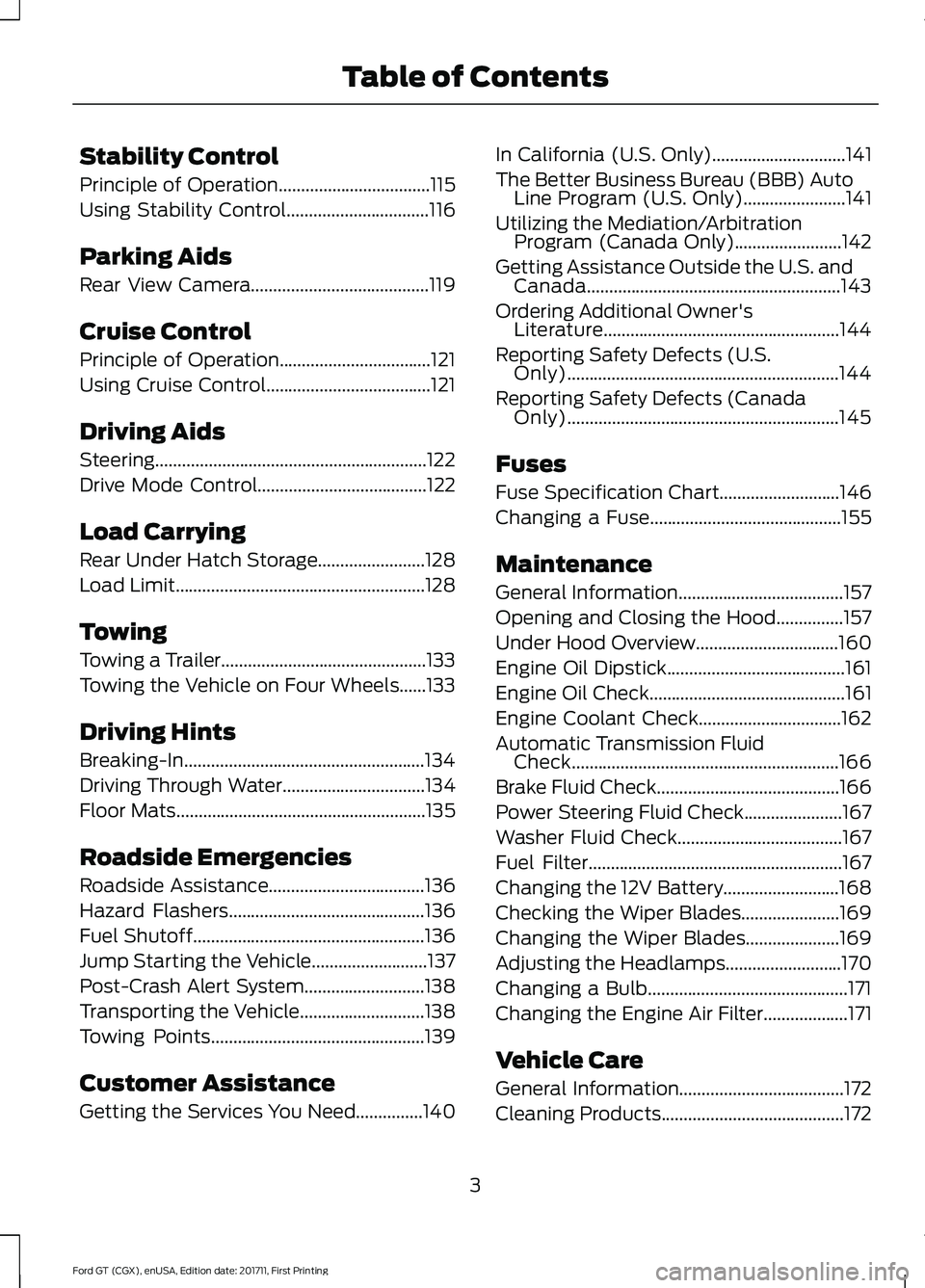
Stability Control
Principle of Operation..................................115
Using Stability Control
................................116
Parking Aids
Rear View Camera........................................119
Cruise Control
Principle of Operation..................................121
Using Cruise Control.....................................121
Driving Aids
Steering.............................................................122
Drive Mode Control......................................122
Load Carrying
Rear Under Hatch Storage........................128
Load Limit........................................................128
Towing
Towing a Trailer..............................................133
Towing the Vehicle on Four Wheels......133
Driving Hints
Breaking-In......................................................134
Driving Through Water................................134
Floor Mats
........................................................135
Roadside Emergencies
Roadside Assistance
...................................136
Hazard Flashers
............................................136
Fuel Shutoff
....................................................136
Jump Starting the Vehicle..........................137
Post-Crash Alert System...........................138
Transporting the Vehicle............................138
Towing Points
................................................139
Customer Assistance
Getting the Services You Need...............140 In California (U.S. Only)
..............................141
The Better Business Bureau (BBB) Auto Line Program (U.S. Only).......................141
Utilizing the Mediation/Arbitration Program (Canada Only)........................142
Getting Assistance Outside the U.S. and Canada
.........................................................143
Ordering Additional Owner's Literature.....................................................144
Reporting Safety Defects (U.S. Only).............................................................144
Reporting Safety Defects (Canada Only).............................................................145
Fuses
Fuse Specification Chart
...........................146
Changing a Fuse
...........................................155
Maintenance
General Information
.....................................157
Opening and Closing the Hood...............157
Under Hood Overview
................................160
Engine Oil Dipstick........................................161
Engine Oil Check
............................................161
Engine Coolant Check
................................162
Automatic Transmission Fluid Check............................................................166
Brake Fluid Check.........................................166
Power Steering Fluid Check......................167
Washer Fluid Check.....................................167
Fuel Filter
.........................................................167
Changing the 12V Battery..........................168
Checking the Wiper Blades......................169
Changing the Wiper Blades.....................169
Adjusting the Headlamps..........................170
Changing a Bulb.............................................171
Changing the Engine Air Filter
...................171
Vehicle Care
General Information.....................................172
Cleaning Products.........................................172
3
Ford GT (CGX), enUSA, Edition date: 201711, First Printing Table of Contents
Page 82 of 325
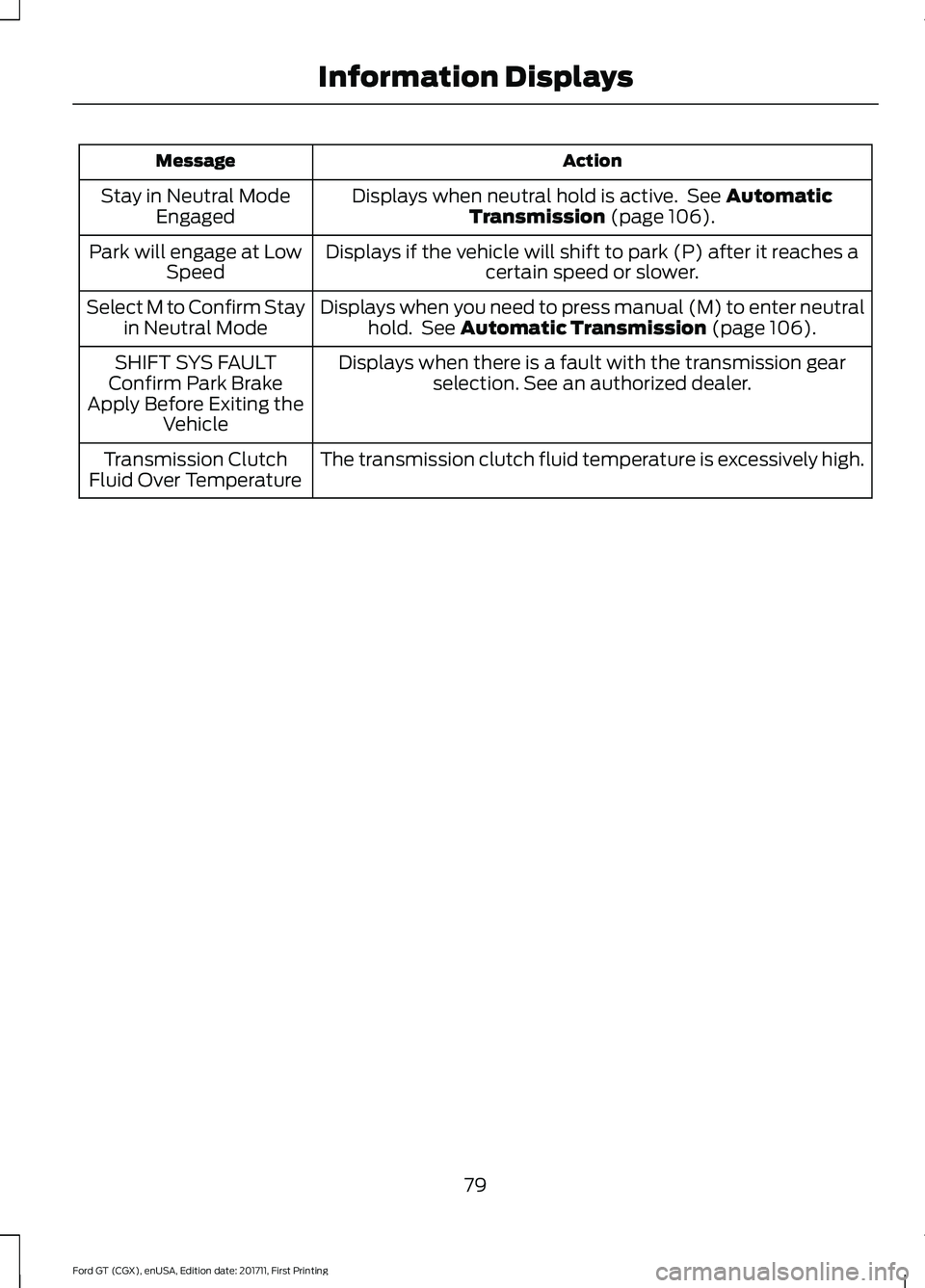
Action
Message
Displays when neutral hold is active. See Automatic
Transmission (page 106).
Stay in Neutral Mode
Engaged
Displays if the vehicle will shift to park (P) after it reaches acertain speed or slower.
Park will engage at Low
Speed
Displays when you need to press manual (M) to enter neutralhold. See
Automatic Transmission (page 106).
Select M to Confirm Stay
in Neutral Mode
Displays when there is a fault with the transmission gearselection. See an authorized dealer.
SHIFT SYS FAULT
Confirm Park Brake
Apply Before Exiting the Vehicle
The transmission clutch fluid temperature is excessively high.
Transmission Clutch
Fluid Over Temperature
79
Ford GT (CGX), enUSA, Edition date: 201711, First Printing Information Displays
Page 107 of 325
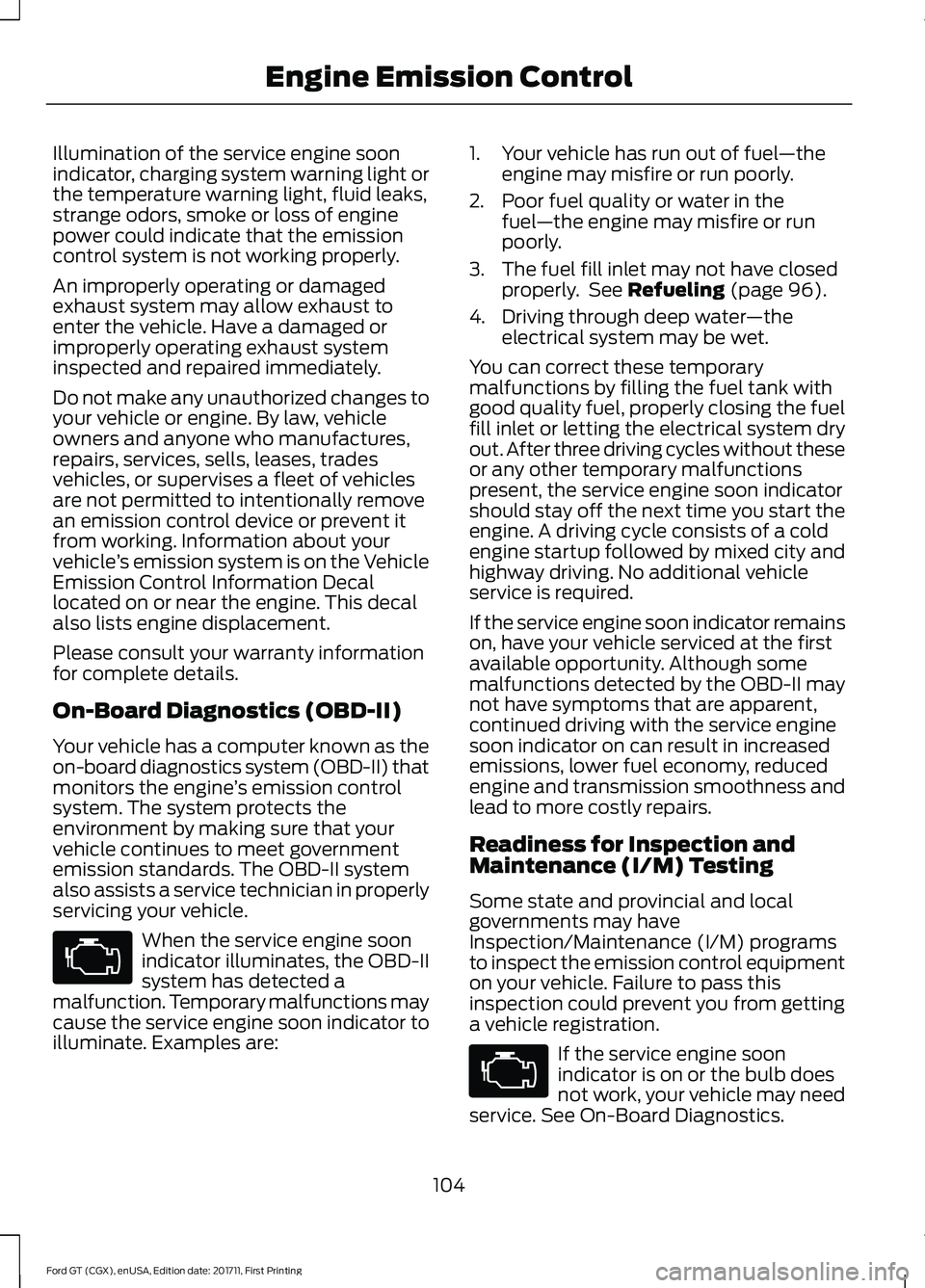
Illumination of the service engine soon
indicator, charging system warning light or
the temperature warning light, fluid leaks,
strange odors, smoke or loss of engine
power could indicate that the emission
control system is not working properly.
An improperly operating or damaged
exhaust system may allow exhaust to
enter the vehicle. Have a damaged or
improperly operating exhaust system
inspected and repaired immediately.
Do not make any unauthorized changes to
your vehicle or engine. By law, vehicle
owners and anyone who manufactures,
repairs, services, sells, leases, trades
vehicles, or supervises a fleet of vehicles
are not permitted to intentionally remove
an emission control device or prevent it
from working. Information about your
vehicle
’s emission system is on the Vehicle
Emission Control Information Decal
located on or near the engine. This decal
also lists engine displacement.
Please consult your warranty information
for complete details.
On-Board Diagnostics (OBD-II)
Your vehicle has a computer known as the
on-board diagnostics system (OBD-II) that
monitors the engine ’s emission control
system. The system protects the
environment by making sure that your
vehicle continues to meet government
emission standards. The OBD-II system
also assists a service technician in properly
servicing your vehicle. When the service engine soon
indicator illuminates, the OBD-II
system has detected a
malfunction. Temporary malfunctions may
cause the service engine soon indicator to
illuminate. Examples are: 1. Your vehicle has run out of fuel
—the
engine may misfire or run poorly.
2. Poor fuel quality or water in the fuel —the engine may misfire or run
poorly.
3. The fuel fill inlet may not have closed properly. See Refueling (page 96).
4. Driving through deep water —the
electrical system may be wet.
You can correct these temporary
malfunctions by filling the fuel tank with
good quality fuel, properly closing the fuel
fill inlet or letting the electrical system dry
out. After three driving cycles without these
or any other temporary malfunctions
present, the service engine soon indicator
should stay off the next time you start the
engine. A driving cycle consists of a cold
engine startup followed by mixed city and
highway driving. No additional vehicle
service is required.
If the service engine soon indicator remains
on, have your vehicle serviced at the first
available opportunity. Although some
malfunctions detected by the OBD-II may
not have symptoms that are apparent,
continued driving with the service engine
soon indicator on can result in increased
emissions, lower fuel economy, reduced
engine and transmission smoothness and
lead to more costly repairs.
Readiness for Inspection and
Maintenance (I/M) Testing
Some state and provincial and local
governments may have
Inspection/Maintenance (I/M) programs
to inspect the emission control equipment
on your vehicle. Failure to pass this
inspection could prevent you from getting
a vehicle registration. If the service engine soon
indicator is on or the bulb does
not work, your vehicle may need
service. See On-Board Diagnostics.
104
Ford GT (CGX), enUSA, Edition date: 201711, First Printing Engine Emission Control
Page 121 of 325
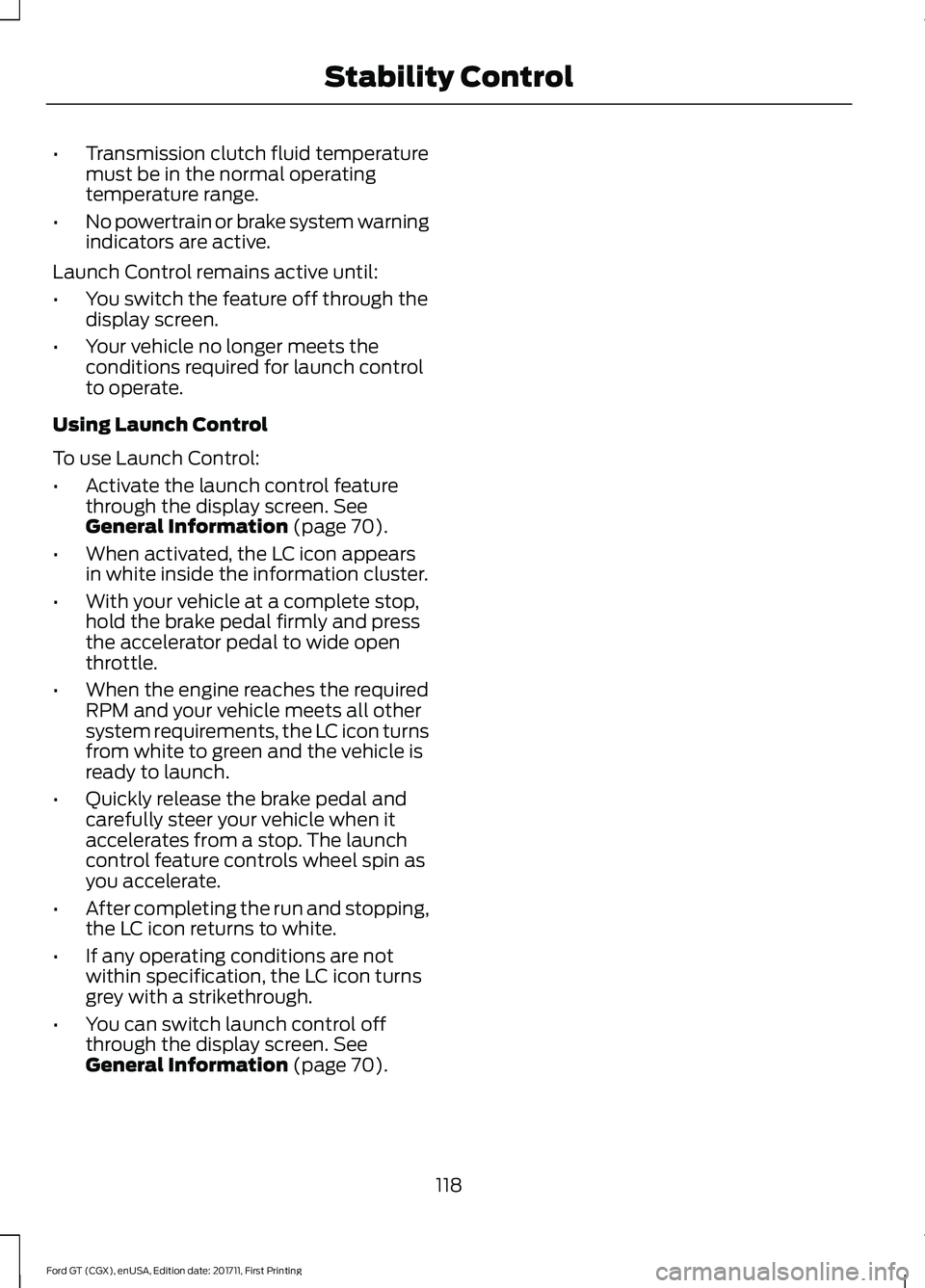
•
Transmission clutch fluid temperature
must be in the normal operating
temperature range.
• No powertrain or brake system warning
indicators are active.
Launch Control remains active until:
• You switch the feature off through the
display screen.
• Your vehicle no longer meets the
conditions required for launch control
to operate.
Using Launch Control
To use Launch Control:
• Activate the launch control feature
through the display screen. See
General Information (page 70).
• When activated, the LC icon appears
in white inside the information cluster.
• With your vehicle at a complete stop,
hold the brake pedal firmly and press
the accelerator pedal to wide open
throttle.
• When the engine reaches the required
RPM and your vehicle meets all other
system requirements, the LC icon turns
from white to green and the vehicle is
ready to launch.
• Quickly release the brake pedal and
carefully steer your vehicle when it
accelerates from a stop. The launch
control feature controls wheel spin as
you accelerate.
• After completing the run and stopping,
the LC icon returns to white.
• If any operating conditions are not
within specification, the LC icon turns
grey with a strikethrough.
• You can switch launch control off
through the display screen.
See
General Information (page 70).
118
Ford GT (CGX), enUSA, Edition date: 201711, First Printing Stability Control
Page 125 of 325
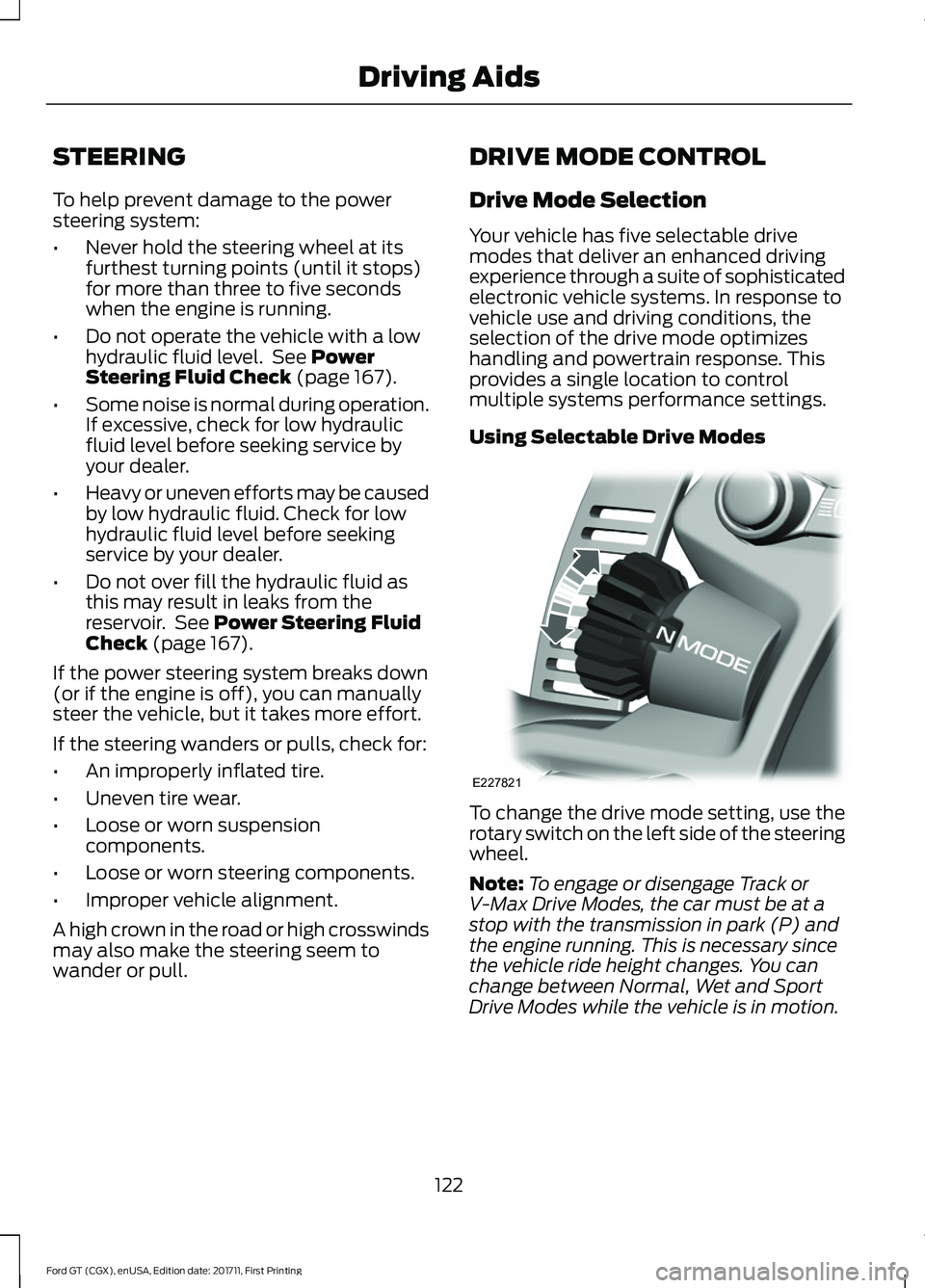
STEERING
To help prevent damage to the power
steering system:
•
Never hold the steering wheel at its
furthest turning points (until it stops)
for more than three to five seconds
when the engine is running.
• Do not operate the vehicle with a low
hydraulic fluid level. See Power
Steering Fluid Check (page 167).
• Some noise is normal during operation.
If excessive, check for low hydraulic
fluid level before seeking service by
your dealer.
• Heavy or uneven efforts may be caused
by low hydraulic fluid. Check for low
hydraulic fluid level before seeking
service by your dealer.
• Do not over fill the hydraulic fluid as
this may result in leaks from the
reservoir. See
Power Steering Fluid
Check (page 167).
If the power steering system breaks down
(or if the engine is off), you can manually
steer the vehicle, but it takes more effort.
If the steering wanders or pulls, check for:
• An improperly inflated tire.
• Uneven tire wear.
• Loose or worn suspension
components.
• Loose or worn steering components.
• Improper vehicle alignment.
A high crown in the road or high crosswinds
may also make the steering seem to
wander or pull. DRIVE MODE CONTROL
Drive Mode Selection
Your vehicle has five selectable drive
modes that deliver an enhanced driving
experience through a suite of sophisticated
electronic vehicle systems. In response to
vehicle use and driving conditions, the
selection of the drive mode optimizes
handling and powertrain response. This
provides a single location to control
multiple systems performance settings.
Using Selectable Drive Modes
To change the drive mode setting, use the
rotary switch on the left side of the steering
wheel.
Note:
To engage or disengage Track or
V-Max Drive Modes, the car must be at a
stop with the transmission in park (P) and
the engine running. This is necessary since
the vehicle ride height changes. You can
change between Normal, Wet and Sport
Drive Modes while the vehicle is in motion.
122
Ford GT (CGX), enUSA, Edition date: 201711, First Printing Driving AidsE227821
Page 154 of 325
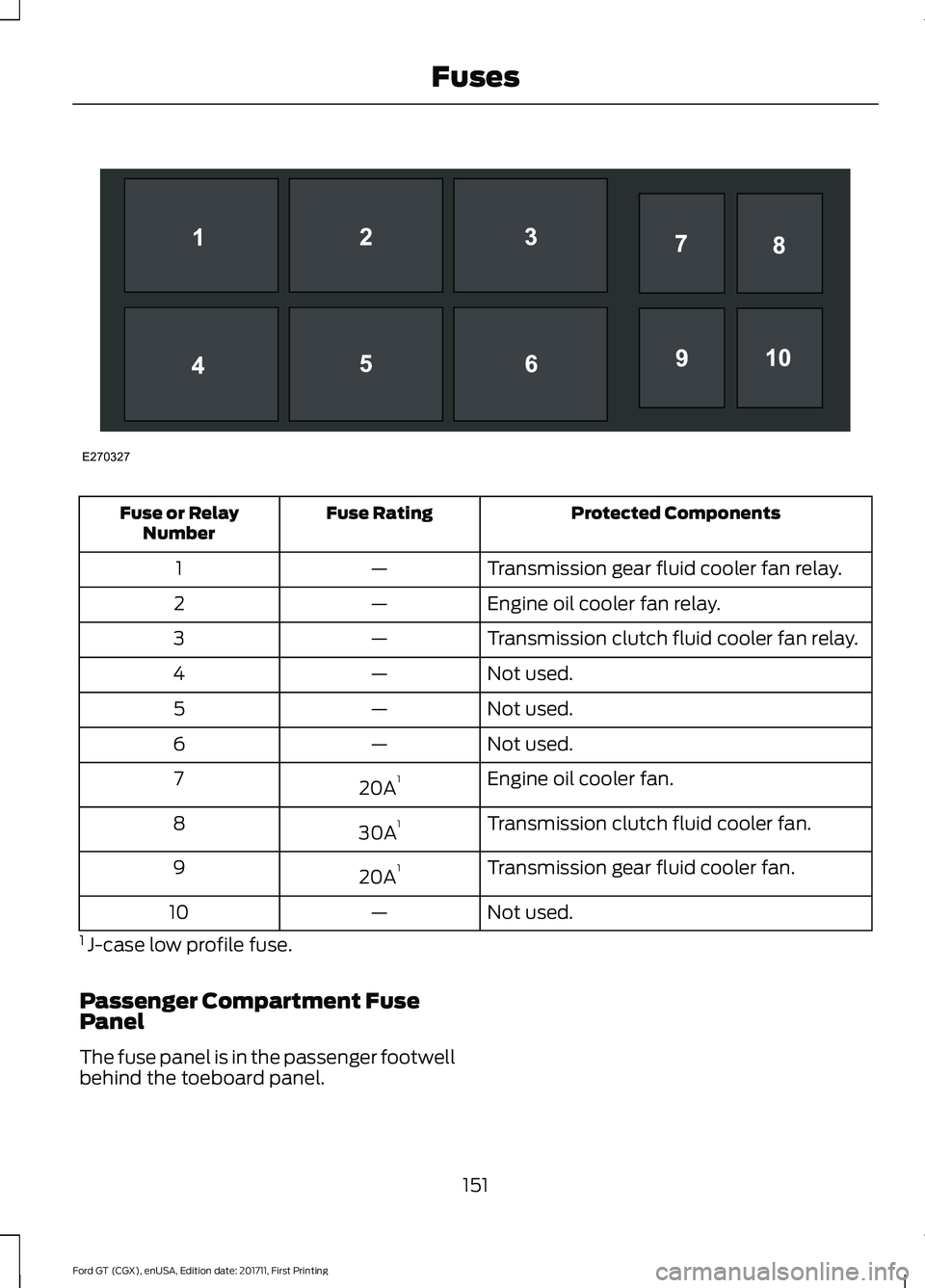
Protected Components
Fuse Rating
Fuse or Relay
Number
Transmission gear fluid cooler fan relay.
—
1
Engine oil cooler fan relay.
—
2
Transmission clutch fluid cooler fan relay.
—
3
Not used.
—
4
Not used.
—
5
Not used.
—
6
Engine oil cooler fan.
20A 1
7
Transmission clutch fluid cooler fan.
30A 1
8
Transmission gear fluid cooler fan.
20A 1
9
Not used.
—
10
1 J-case low profile fuse.
Passenger Compartment Fuse
Panel
The fuse panel is in the passenger footwell
behind the toeboard panel.
151
Ford GT (CGX), enUSA, Edition date: 201711, First Printing FusesE270327
Page 169 of 325
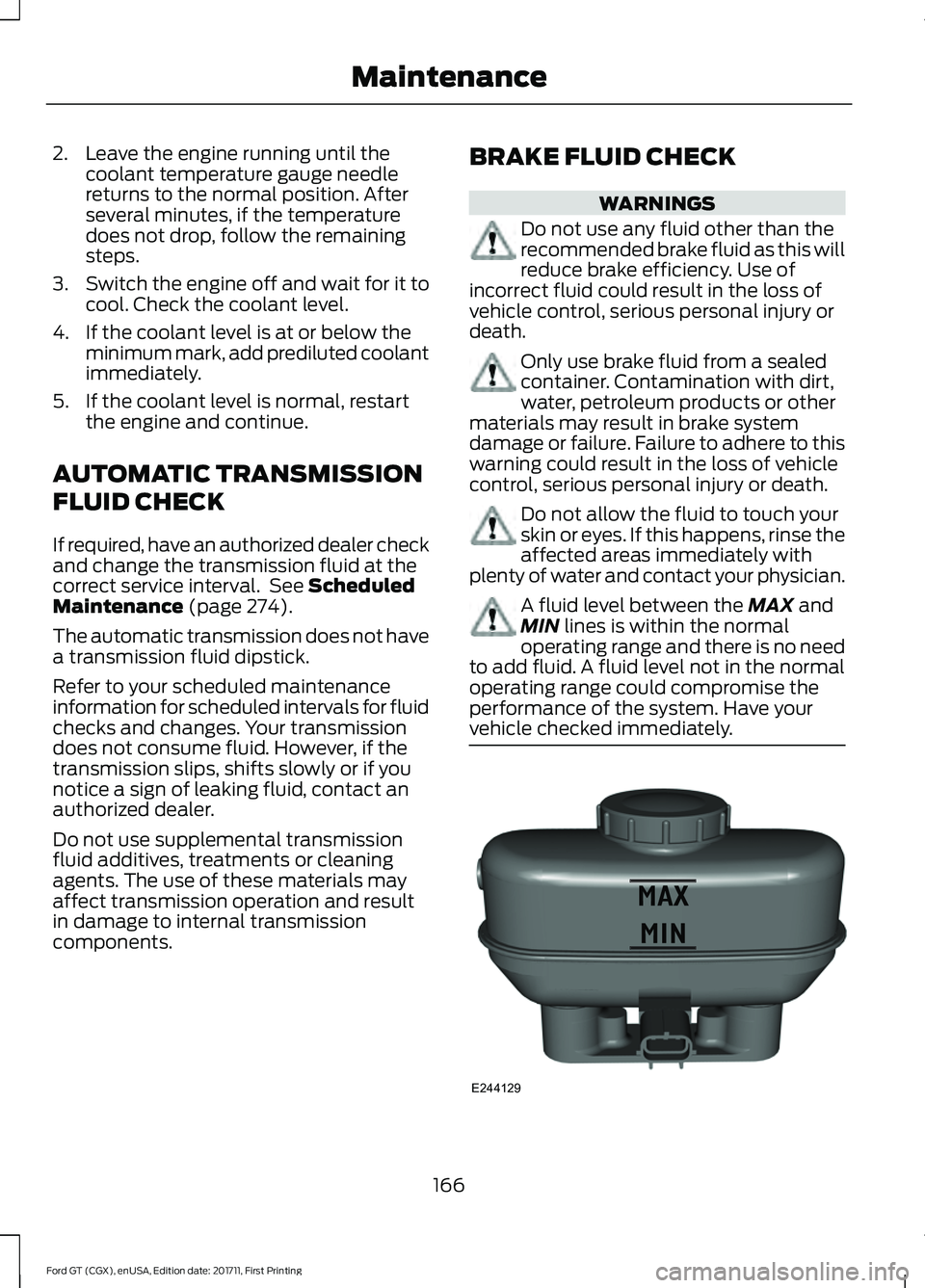
2. Leave the engine running until the
coolant temperature gauge needle
returns to the normal position. After
several minutes, if the temperature
does not drop, follow the remaining
steps.
3. Switch the engine off and wait for it to
cool. Check the coolant level.
4. If the coolant level is at or below the minimum mark, add prediluted coolant
immediately.
5. If the coolant level is normal, restart the engine and continue.
AUTOMATIC TRANSMISSION
FLUID CHECK
If required, have an authorized dealer check
and change the transmission fluid at the
correct service interval. See Scheduled
Maintenance (page 274).
The automatic transmission does not have
a transmission fluid dipstick.
Refer to your scheduled maintenance
information for scheduled intervals for fluid
checks and changes. Your transmission
does not consume fluid. However, if the
transmission slips, shifts slowly or if you
notice a sign of leaking fluid, contact an
authorized dealer.
Do not use supplemental transmission
fluid additives, treatments or cleaning
agents. The use of these materials may
affect transmission operation and result
in damage to internal transmission
components. BRAKE FLUID CHECK WARNINGS
Do not use any fluid other than the
recommended brake fluid as this will
reduce brake efficiency. Use of
incorrect fluid could result in the loss of
vehicle control, serious personal injury or
death. Only use brake fluid from a sealed
container. Contamination with dirt,
water, petroleum products or other
materials may result in brake system
damage or failure. Failure to adhere to this
warning could result in the loss of vehicle
control, serious personal injury or death. Do not allow the fluid to touch your
skin or eyes. If this happens, rinse the
affected areas immediately with
plenty of water and contact your physician. A fluid level between the MAX and
MIN lines is within the normal
operating range and there is no need
to add fluid. A fluid level not in the normal
operating range could compromise the
performance of the system. Have your
vehicle checked immediately. 166
Ford GT (CGX), enUSA, Edition date: 201711, First Printing MaintenanceE244129
Page 212 of 325
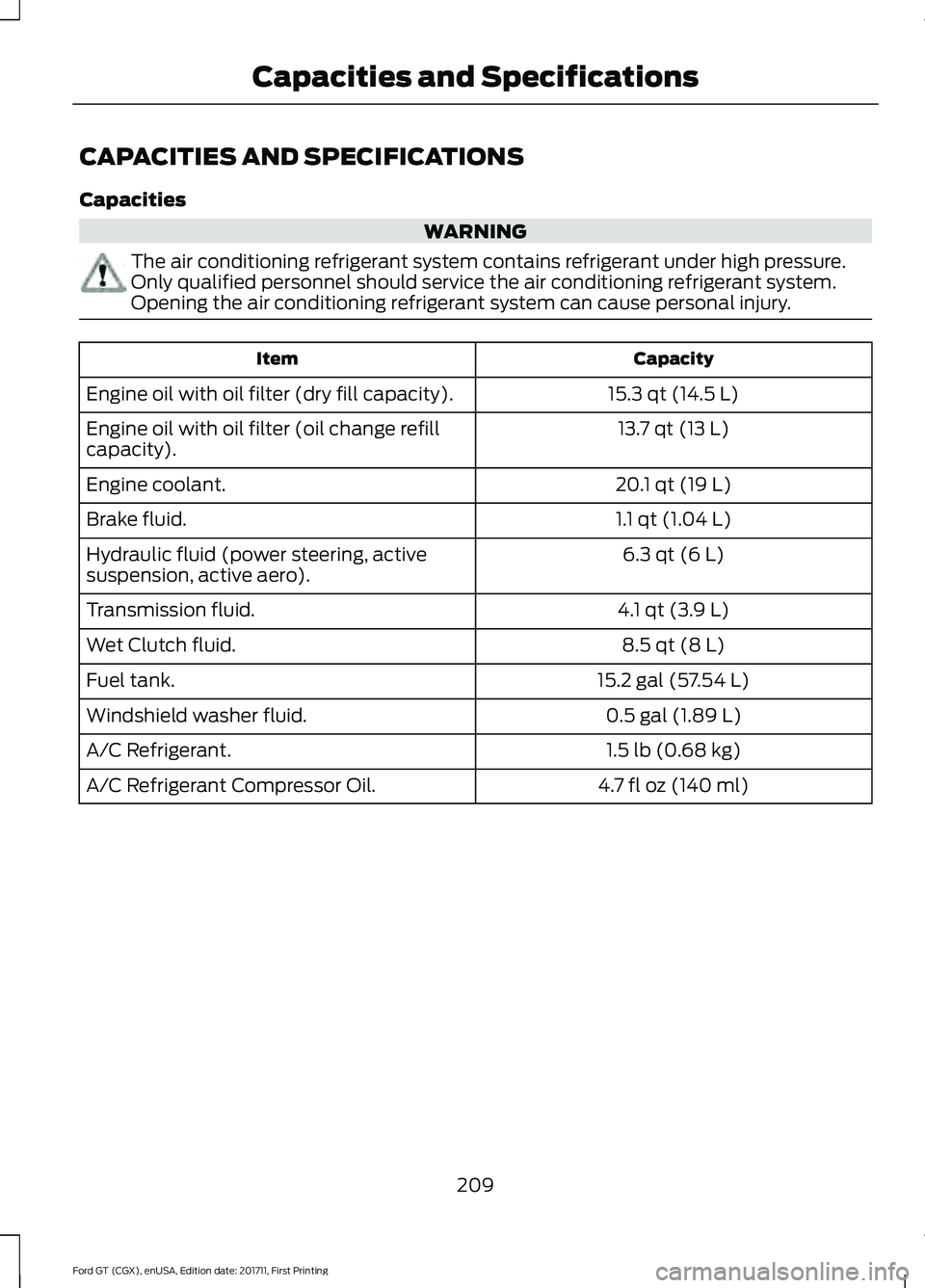
CAPACITIES AND SPECIFICATIONS
Capacities
WARNING
The air conditioning refrigerant system contains refrigerant under high pressure.
Only qualified personnel should service the air conditioning refrigerant system.
Opening the air conditioning refrigerant system can cause personal injury.
Capacity
Item
15.3 qt (14.5 L)
Engine oil with oil filter (dry fill capacity).
13.7 qt (13 L)
Engine oil with oil filter (oil change refill
capacity).
20.1 qt (19 L)
Engine coolant.
1.1 qt (1.04 L)
Brake fluid.
6.3 qt (6 L)
Hydraulic fluid (power steering, active
suspension, active aero).
4.1 qt (3.9 L)
Transmission fluid.
8.5 qt (8 L)
Wet Clutch fluid.
15.2 gal (57.54 L)
Fuel tank.
0.5 gal (1.89 L)
Windshield washer fluid.
1.5 lb (0.68 kg)
A/C Refrigerant.
4.7 fl oz (140 ml)
A/C Refrigerant Compressor Oil.
209
Ford GT (CGX), enUSA, Edition date: 201711, First Printing Capacities and Specifications
Page 213 of 325
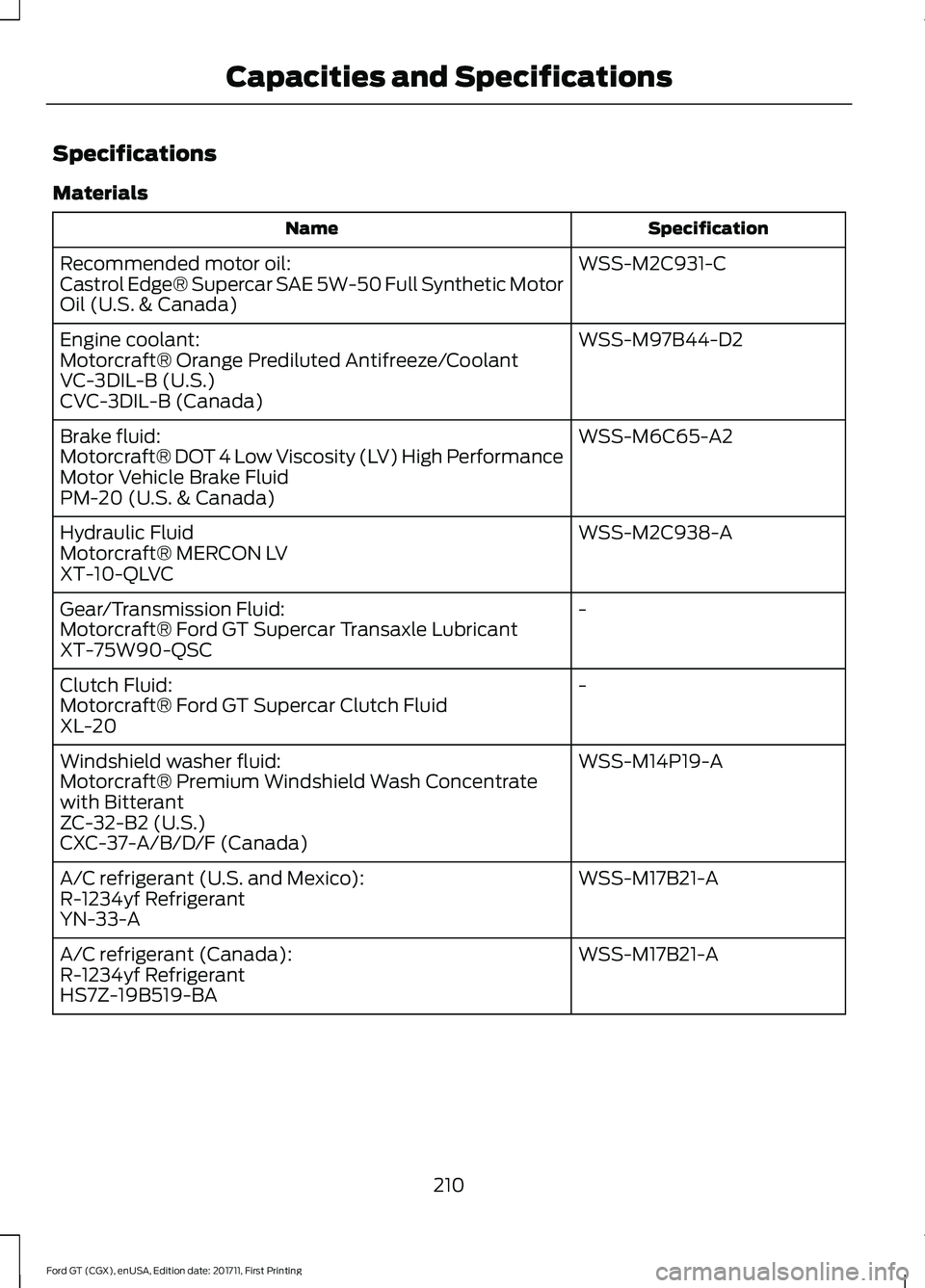
Specifications
Materials
Specification
Name
WSS-M2C931-C
Recommended motor oil:
Castrol Edge® Supercar SAE 5W-50 Full Synthetic Motor
Oil (U.S. & Canada)
WSS-M97B44-D2
Engine coolant:
Motorcraft® Orange Prediluted Antifreeze/Coolant
VC-3DIL-B (U.S.)
CVC-3DIL-B (Canada)
WSS-M6C65-A2
Brake fluid:
Motorcraft® DOT 4 Low Viscosity (LV) High Performance
Motor Vehicle Brake Fluid
PM-20 (U.S. & Canada)
WSS-M2C938-A
Hydraulic Fluid
Motorcraft® MERCON LV
XT-10-QLVC
-
Gear/Transmission Fluid:
Motorcraft® Ford GT Supercar Transaxle Lubricant
XT-75W90-QSC
-
Clutch Fluid:
Motorcraft® Ford GT Supercar Clutch Fluid
XL-20
WSS-M14P19-A
Windshield washer fluid:
Motorcraft® Premium Windshield Wash Concentrate
with Bitterant
ZC-32-B2 (U.S.)
CXC-37-A/B/D/F (Canada)
WSS-M17B21-A
A/C refrigerant (U.S. and Mexico):
R-1234yf Refrigerant
YN-33-A
WSS-M17B21-A
A/C refrigerant (Canada):
R-1234yf Refrigerant
HS7Z-19B519-BA
210
Ford GT (CGX), enUSA, Edition date: 201711, First Printing Capacities and Specifications
Page 279 of 325
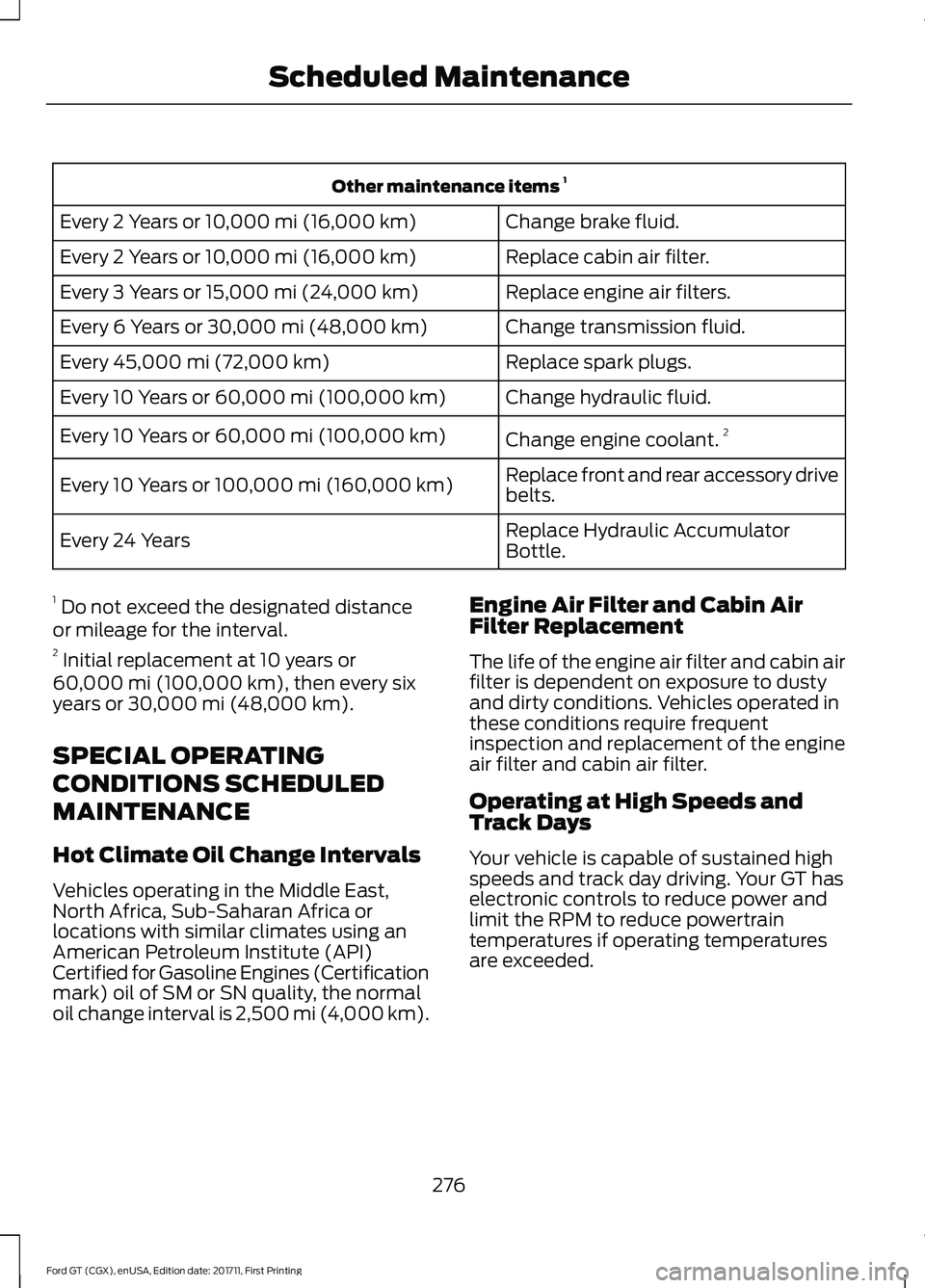
Other maintenance items
1
Change brake fluid.
Every 2 Years or 10,000 mi (16,000 km)
Replace cabin air filter.
Every 2 Years or
10,000 mi (16,000 km)
Replace engine air filters.
Every 3 Years or
15,000 mi (24,000 km)
Change transmission fluid.
Every 6 Years or
30,000 mi (48,000 km)
Replace spark plugs.
Every
45,000 mi (72,000 km)
Change hydraulic fluid.
Every 10 Years or
60,000 mi (100,000 km)
Change engine coolant.2
Every 10 Years or
60,000 mi (100,000 km)
Replace front and rear accessory drive
belts.
Every 10 Years or
100,000 mi (160,000 km)
Replace Hydraulic Accumulator
Bottle.
Every 24 Years
1 Do not exceed the designated distance
or mileage for the interval.
2 Initial replacement at 10 years or
60,000 mi (100,000 km)
, then every six
years or 30,000 mi (48,000 km).
SPECIAL OPERATING
CONDITIONS SCHEDULED
MAINTENANCE
Hot Climate Oil Change Intervals
Vehicles operating in the Middle East,
North Africa, Sub-Saharan Africa or
locations with similar climates using an
American Petroleum Institute (API)
Certified for Gasoline Engines (Certification
mark) oil of SM or SN quality, the normal
oil change interval is 2,500 mi (4,000 km). Engine Air Filter and Cabin Air
Filter Replacement
The life of the engine air filter and cabin air
filter is dependent on exposure to dusty
and dirty conditions. Vehicles operated in
these conditions require frequent
inspection and replacement of the engine
air filter and cabin air filter.
Operating at High Speeds and
Track Days
Your vehicle is capable of sustained high
speeds and track day driving. Your GT has
electronic controls to reduce power and
limit the RPM to reduce powertrain
temperatures if operating temperatures
are exceeded.
276
Ford GT (CGX), enUSA, Edition date: 201711, First Printing Scheduled Maintenance